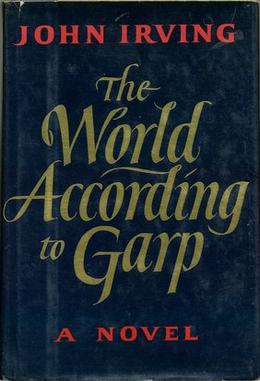
The World According to Garp is John Irving's fourth novel, about a man who is born out of wedlock to a feminist leader, then grows up to be a writer. Published in 1978, the book was a bestseller for several years. It was a finalist for the National Book Award for Fiction in 1979, and its first paperback edition won the award the following year.

The Boys of Summer is a 1972 non-fiction baseball book by Roger Kahn. After recounting his childhood in Brooklyn and his life as a young reporter on the New York Herald Tribune, the author relates some history of the Brooklyn Dodgers up to their victory in the 1955 World Series. He then tracks the lives of the players over the subsequent years as they aged. The title of the book is taken from a Dylan Thomas poem that describes "the boys of summer in their ruin".

Goodbye, Mickey Mouse is a historical novel by Len Deighton published on 12 October 1982. Set in Britain in early 1944 it tells the story of the 220th Fighter Group of the US Eighth Air Force in the lead up to the Allied invasion of Europe. The Group is based at a fictional airfield in Norfolk named Steeple Thaxted.

Roger Williams Straus Jr. was co-founder and chairman of Farrar, Straus and Giroux, a New York book publishing company, and member of the Guggenheim family.
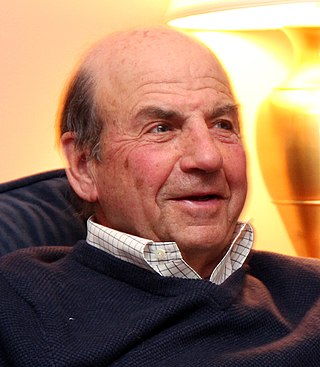
Calvin Marshall Trillin is an American journalist, humorist, food writer, poet, memoirist and novelist. He is a winner of the Thurber Prize for American Humor (2012) and an elected member of the American Academy of Arts and Letters (2008).
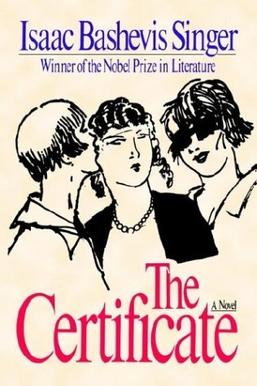
The Certificate is a novel by Isaac Bashevis Singer, published in English in 1992. David Bendinger, a poor, young Yiddish writer wishes to emigrate to Palestine from Poland, and because married couples are given preference, he tries to arrange for a marriage certificate to be purchased for him by a wealthy woman whose fiancee lives in Palestine. The narrative deals with the abject poverty of David, as well as his Jewish heritage, and details the rise of both Communism and Zionism.

Leslie Aaron Fiedler was an American literary critic, known for his interest in mythography and his championing of genre fiction. His work incorporates the application of psychological theories to American literature. Fiedler's best known work is the book Love and Death in the American Novel (1960). A retrospective article on Leslie Fiedler in the New York Times Book Review in 1965 referred to Love and Death in the American Novel as "one of the great, essential books on the American imagination ... an accepted major work." This work views in depth both American literature and character from the time of the American Revolution to the present. From it, there emerges Fiedler's once scandalous—now increasingly accepted—judgement that American literature is incapable of dealing with adult sexuality and is pathologically obsessed with death.
Our great novelists, though experts on indignity and assault, on loneliness and terror, tend to avoid treating the passionate encounter of a man and a woman, which we expect at the center of a novel. Indeed, they rather shy away from permitting in their fictions the presence of any full-fledged, mature women, giving us instead monsters of virtue or bitchery, symbols of the rejection or fear of sexuality.
Christopher Lehmann-Haupt was an American journalist, editor of the New York Times Book Review, critic, and novelist, based in New York City. He served as senior Daily Book Reviewer from 1969 to 1995.
Ronald Sukenick was an American writer and literary theorist.

George V. Higgins was an American author, lawyer, newspaper columnist, raconteur and college professor. He authored more than thirty books, including Bomber's Law,Trust, and Kennedy for the Defense, and is best known for his bestselling crime novels, including The Friends of Eddie Coyle, which established the Boston noir genre of gangster tales that spawned several popular films by followers in the late 20th and early 21st centuries.

The Making of the Representative for Planet 8 is a 1982 science fiction novel by Doris Lessing. It is the fourth book in her five-book Canopus in Argos series and relates the fate of a planet, under the care of the benevolent galactic empire Canopus, that is plunged into an ice age. It was first published in the United States in January 1982 by Alfred A. Knopf, and in the United Kingdom in March 1982 by Jonathan Cape.

The Day of the Dolphin is a 1967 science fiction thriller novel by French novelist Robert Merle. The plot concerns dolphins that are trained to communicate with humans, and their use in warfare. The central character is a government scientist with similar ideas to those of John C. Lilly.

Sailor Song is a 1992 novel written by Ken Kesey. The only work of long fiction solely written by Kesey after Sometimes a Great Notion (1964), Sailor Song depicts the lives of the residents of Kuinak, a small town in Alaska, thirty years in the future – the 2020s.
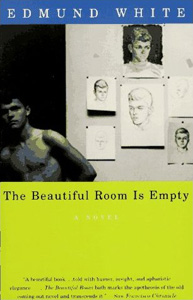
The Beautiful Room Is Empty is a 1988 semi-autobiographical novel by Edmund White.
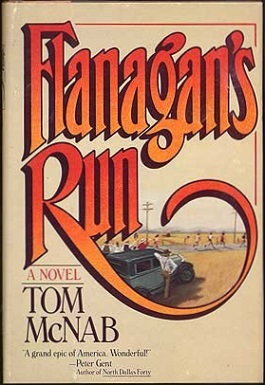
Flanagan's Run is a 1982 novel written by Scottish athlete and author Tom McNab.
The Downtown Diaries is a book written by Jim Carroll depicting his life from the years 1971 to 1973. While the book was called The Downtown Diaries, it was not a literal diary, such as The Basketball Diaries. Carroll had stated that most of Forced Entries was written by memory and may or may not have been totally accurate...
Young Hearts Crying is the penultimate novel of American writer Richard Yates.
Nora Clemens Sayre was an American film critic and essayist. She was a reviewer of films for The New York Times in the 1970s, and, from 1981, a writing teacher for many years at Columbia University. She specialized in the Cold War and authored books such as Running Time: Films of the Cold War (1982) in which she examined Hollywood movie-making in the 1950s.
The Miracle Game is a Czech novel by Josef Škvorecký published in 1972 by Sixty Eight Publishers in Toronto, Canada. It was translated into English in 1990 by Paul Wilson, and according to The Times is Skvorecky's masterpiece. It was his response to Prague Spring events of 1968 Czechoslovakia. and contains unflattering references to real people, Future Czech President Václav Havel becomes "the world-famous playwright Hejl", the writer Bohumil Hrabal appears as the "gifted non-party novelist Nabal".

The Good Son is a 1982 novel by Craig Nova.














